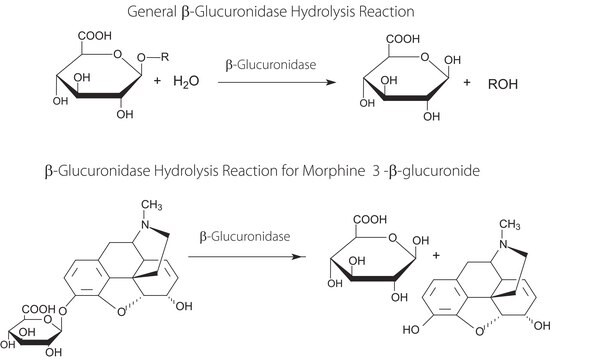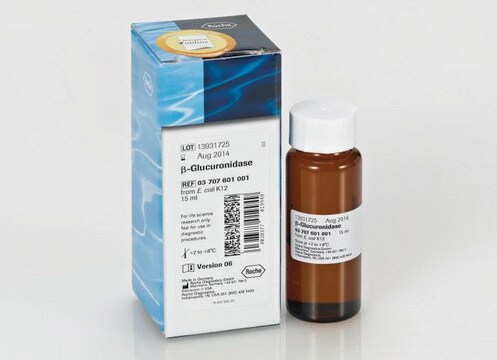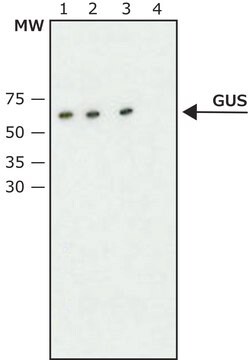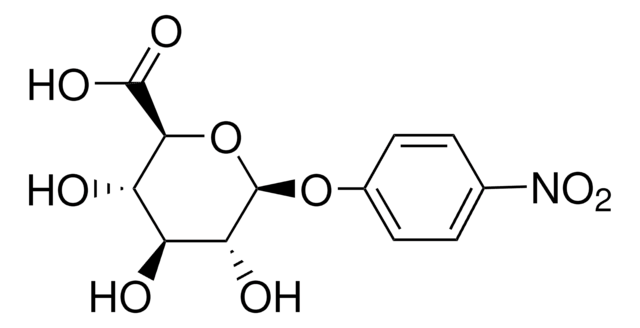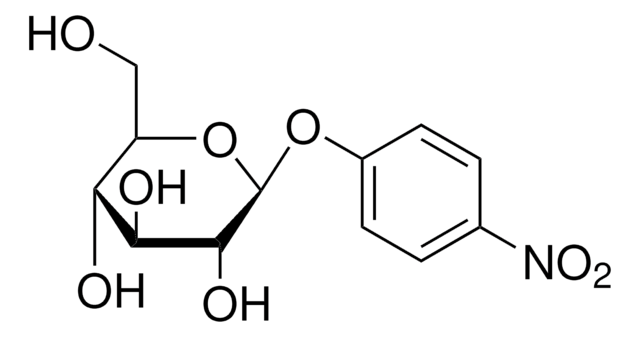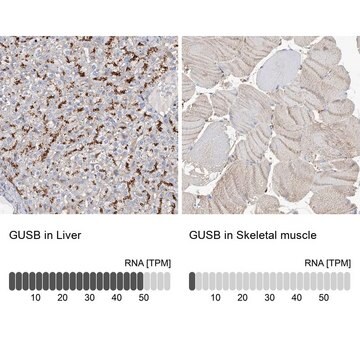Alle Fotos(1)
Wichtige Dokumente
G5420
Anti-β-Glucuronidase (N-Terminal) antibody produced in rabbit
~1.5 mg/mL, affinity isolated antibody, buffered aqueous solution
Synonym(e):
Anti-GUS
Anmeldenzur Ansicht organisationsspezifischer und vertraglich vereinbarter Preise
Alle Fotos(1)
About This Item
Empfohlene Produkte
Biologische Quelle
rabbit
Qualitätsniveau
Konjugat
unconjugated
Antikörperform
affinity isolated antibody
Antikörper-Produkttyp
primary antibodies
Klon
polyclonal
Form
buffered aqueous solution
Mol-Gew.
antigen 60 kDa
Speziesreaktivität
plant
Konzentration
~1.5 mg/mL
Methode(n)
western blot: 0.5-1 μg/mL using GUS purified from E. coli
Versandbedingung
dry ice
Lagertemp.
−20°C
Posttranslationale Modifikation Target
unmodified
Allgemeine Beschreibung
β-Glucuronidase (GUS) is encoded by the E. coli gus gene (also referred to as uidA), GUS protein (60 kDa) is an hydrolase.
Spezifität
Anti-β-Glucuronidase (N-Terminal) recognizes bacterial GUS expressed in transgenic tobacco plants.
Immunogen
Sythetic peptide corresponding to amino acids located at the N-terminus of E. coli GUS, conjugated to KLH.
Anwendung
Anti-β-Glucuronidase (N-Terminal) antibody produced in rabbit has been used in western blotting.
Rabbit polyclonal anti-β-Glucuronidase (N-Terminal) antibody may be used for the detection of GUS by immunoblotting (60 kDa). It may be used to detect the reporter GUS marker protein in transgenic plants.
Biochem./physiol. Wirkung
β-Glucuronidase (GUS) is a screenable markers E. coli GUS has been extensively used to monitor transgene delivery to plant tissue.
β-Glucuronidase catalyzes the cleavage of terminal glucuronic acid bound by β-linkage from mono-, oligo-, or polysaccharides or phenols. GUS is mainly used as a marker during transgenic events. In vitro GUS activity assays predominantly facilitates histochemical and fluorometric localization in tissues. GUS activity is also used for the analysis of expression of foreign genes. GUS reporter genes fused with specific promoter genes have been used for the determination of transformed tissues on culture media containing antibiotics. GUS-specific antibodies are helpful in detecting GUS gene product in transformed plants.
Physikalische Form
Solution in 0.01 M phosphate buffered saline, pH 7.4, containing 15 mM sodium azide.
Lagerung und Haltbarkeit
For continuous use, store at 2-8 °C for up to one month. For extended storage, freeze in working aliquots. Repeated freezing and thawing, or storage in “frostfree” freezers, is not recommended. If slight turbidity occurs upon prolonged storage, clarify the solution by centrifugation before use. Working dilutions should be discarded if not used within 12 hours.
Haftungsausschluss
Unless otherwise stated in our catalog or other company documentation accompanying the product(s), our products are intended for research use only and are not to be used for any other purpose, which includes but is not limited to, unauthorized commercial uses, in vitro diagnostic uses, ex vivo or in vivo therapeutic uses or any type of consumption or application to humans or animals.
Sie haben nicht das passende Produkt gefunden?
Probieren Sie unser Produkt-Auswahlhilfe. aus.
Ähnliches Produkt
Produkt-Nr.
Beschreibung
Preisangaben
Lagerklassenschlüssel
10 - Combustible liquids
WGK
WGK 3
Flammpunkt (°F)
Not applicable
Flammpunkt (°C)
Not applicable
Hier finden Sie alle aktuellen Versionen:
Besitzen Sie dieses Produkt bereits?
In der Dokumentenbibliothek finden Sie die Dokumentation zu den Produkten, die Sie kürzlich erworben haben.
Bacterial glucuronidase as general marker for oncolytic virotherapy or other biological therapies
Hess M, et al.
Journal of Translational Medicine, 9(1), 172-172 (2011)
Michael Hess et al.
Journal of translational medicine, 9, 172-172 (2011-10-13)
Oncolytic viral tumor therapy is an emerging field in the fight against cancer with rising numbers of clinical trials and the first clinically approved product (Adenovirus for the treatment of Head and Neck Cancer in China) in this field. Yet
Release of the recombinant proteins, human serum albumin, ?-glucuronidase, glycoprotein B from human cytomegalovirus, and green fluorescent protein, in root exudates from transgenic tobacco and their effects on microbes and enzymatic activities in soil
Sabharwal N, et al.
Plant Physiology and Biochemistry, 45(6-7), 464-469 (2007)
Vascular-specific expression of GUS and GFP reporter genes in transgenic grapevine (Vitis vinifera L. cv. Albarin
Gago J, et al.
Plant Physiology and Biochemistry, 49(4), 413-419 (2011)
Impact of ubiquitous inhibitors on the GUS gene reporter system: evidence from the model plants Arabidopsis, tobacco and rice and correction methods for quantitative assays of transgenic and endogenous GUS
Fior S, et al.
Plant methods, 5(1), 19-19 (2009)
Unser Team von Wissenschaftlern verfügt über Erfahrung in allen Forschungsbereichen einschließlich Life Science, Materialwissenschaften, chemischer Synthese, Chromatographie, Analytik und vielen mehr..
Setzen Sie sich mit dem technischen Dienst in Verbindung.